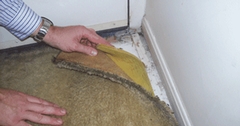Blog Post
All About Mold Series – #5 Signs That You May Have Mold In Your House

The following are common red flags that could indicate you have mold growing in your house…
Allergic Symptoms
If you are having a chronic problem with allergies or notice that your allergies seem to improve once you leave the building, perhaps the spore counts in your home could be elevated due to some mold growth beyond that of normal. RECALL that ALL buildings have a level of "normal fungal ecology" know as "Condition 1". Paying attention to how your body reacts from building to building could help you identify a pattern. For example, one's allergies seem to be bothersome in their home, but upon going to a friends home they seem to subside – this could be an indicator that some degree of abnormal growth is taking place in your home. Also be sure to check with local weather forecasting to see if mold counts are generally elevated due to the time of year – this also can be a contributing factor. If the allergy-like symptoms stay with you outside then certainly pay attention when you go back inside. But it could be a simple fact that replacement air being allowed into the home is seasonally high in mold counts. However, if you go outside and symptoms improve, then it may be a viable plan to have an air-quality test performed to isolate the issues. 1st Call Disaster Services can assist you with this process.
Common allergic reactions to mold include sneezing, sore eyes, a runny nose or nasal congestion, and sinus headaches. When you breathe in mold spores, your immune system responds by creating an allergic reaction. The response can become more and more sensitive and dangerous to your health over time depending on how your body reacts. RECALL: it is not accurate to say, "I'm allergic to mold" as this statement fails to recognize that there are some 100,000 species of identified mold! So which one is it that is bothering you at the moment is process that is administered by medical professionals.
Smelling a Mold Odor
Often a "moldy" smell might be the only clue that you have mold growing in some unseen area of your home. If the odor persist it is not wise to ignore mold odors even if mold colonies are not visible to the naked eye. It is an indicator that moisture levels are too high for one reason or another. Begin by performing a thorough inspection of your home specifically focusing on areas where elevated moisture may be chronic. Should active colonies be found and assuming some of the symptoms mentioned above are present, it's advisable to hire a professional who routinely remediates mold related issues to further investigate. At some point it MAY be advisable to engage an IEP (Indoor Environmental Professional) depending on the severity of the issue and the remediation professional can assist with this. Be aware of professionals that offer their own in-house testing! This is largely a conflict of interests. The inspection should always begin at the location of the visible growth and propagate outward from there. IF colonies or discoloration are NOT present then the next logical place to seek out are those areas of the structure where moisture levels could be elevated due to water intrusion. Commonsense and logic should always be applied and then verification can take place with various tools such as moisture meters, invasive and non-invasive testing, infrared cameras, etc.
Signs of Mold Growth
If you can visibly see mold growth, even a small amount, you should take action immediately by simply cleaning the area with mild soap and water NOT BLEACH. Utilizing BLEACH as a mold remedy is a complete myth!!!
One can think of mold as a dandelion head in the spring which we all despise. One square inch of a mold colony can contain up to 1,000,000 spores! Compare that to a common dandelion head which contains about 2000 seed pods – WOW. Mold spores can spread quickly especially if conditions are right for propagation (i.e. moisture, food and still air). Herein lies the problem – mold is EVERYWHERE and we will NEVER rid of it and in fact, mold can contribute to great things that we love (think cheese). It is when mold is propagating somewhere and at an abnormal that is not beneficial to one's health.
It is very probable that the small area of mold that is visibly discernible is in reality an indication of a much larger mold colony growing somewhere out-of-sight. Mold takes on many appearances – some types of mold are white and thread-like. Others appear as clusters of black spots while others can be gray-green or gray-brown and even purple. And there is even one type that takes the form of shaving cream in one's hand.
Signs of Water Problems
If you know you've had some water problems in the past, especially long-term and persistent, then this is the first place to suspect and inspect. Water stains or discoloration on walls, ceilings or soft goods (leather, shoes, luggage) are some signs that you have a moisture problem. Peeling or cracking paint or wallpaper are more visible signs that moisture is present. If walls are bowed or warped can indicate moisture has somehow penetrated the substrate and is suspect for mold growth.
Water Leaks
Most water problems in homes are created by leaks. Some very obvious, but some are simple pin holes that grow in size over time or eventually have pipes fail at that weak spot. Mold growth or discoloration found to be growing mysteriously and "in a weird spot" is often the first indicator of this issue. If you have experienced a known water loss or leak and did NOT have it professionally addressed with proper structural drying techniques then the propensity for elevated mold activity is drastically increased. Mold growth from leaks can often be hidden behind a wall or other surface where water or moisture has seeped through over a long period of time. Repair any and all leaks quickly and have them properly and professionally addressed to insure mold growth does not become an issue in your home or business.
Past Flooding
Floods can often create mold growth in places out of view such as behind walls or under floors especially in areas where the flood water remained for the longest period of time. Basements, even without being flooded, are notorious for elevated dampness and moisture. Depending upon the species, mold can begin to grow after a day or two so act quickly to clean-up and dry out the area after a flood incident. RECALL: human appendages CANNOT detect "dry" below surface levels. Our bodies simply do not possess this ability.
Condensation
The presence of condensation in your home indicates that a high level of moisture exists and can be a sign that you have a humidity problem which is often remedied by an HVAC professional's visit. High humidity levels over a prolonged period of time greatly encourage mold growth especially on soft goods and textiles. Condensation creates a build-up of moisture on surfaces such as windows or metal pipes which in turn runs or drips onto surfaces that support mold growth. Rusted indoor pipes, including duct work or dampness upon or hanging as droplets on hard surfaces generally point to elevated condensation levels in your home. This is a problem that can take years to notice but at that point it is noticed the damage is typically more significant beyond surface materials.
Toxic Symptoms from Mold
As previously mentioned, mold has the potential to cause allergic reactions to the immune system. Suffering from neurological symptoms such as headaches, memory loss, dizziness or trouble concentrating, can be linked to exposure to toxic mold growth.
Mycotoxins from toxic mold can cause severe symptoms. Again, if symptoms are worse in your home than in other places, it is time to consider contributing factors – one of which is abnormal mold counts. All "black molds" are NOT toxic as alluded to on the internet and among fear mongers. There are toxic molds that are black but toxic mold species come in a myriad of colors of which black is just ONE. It is true that toxic mold(s) can cause permanent damage to your health. If you suspect toxic mold, contact a professional mold specialist for proper removal and structural drying.
1st Call Disaster Services specializes in eliminating mold issues and providing preventative measures to address areas of moisture intrusion.
A good restoration company can make sure a mold remediation is done right and that you're out of pocket damage liability is kept to a minimum. We';ve helped numerous home and business owners and they and their insurance company always appreciate our surgical approach to restoration!
All About Mold Series
- All About Mold Series - #7 When and Why to Test for Mold
- All About Mold Series - #6 What Happens and What to Expect During a Mold Inspection
- All About Mold Series - #5 Signs That You May Have Mold In Your House
- All About Mold Series - #4 A Detailed Look at Mold Remediation
- All About Mold Series - #3 The Health Effects of Mold
- All About Mold Series - #2 Detecting and Removing Mold. Can Mold Make Me Sick?
- All About Mold Series - #1 Understanding How Mold Thrives Can Help Us Prevent Mold Growth In Your Home or Business
